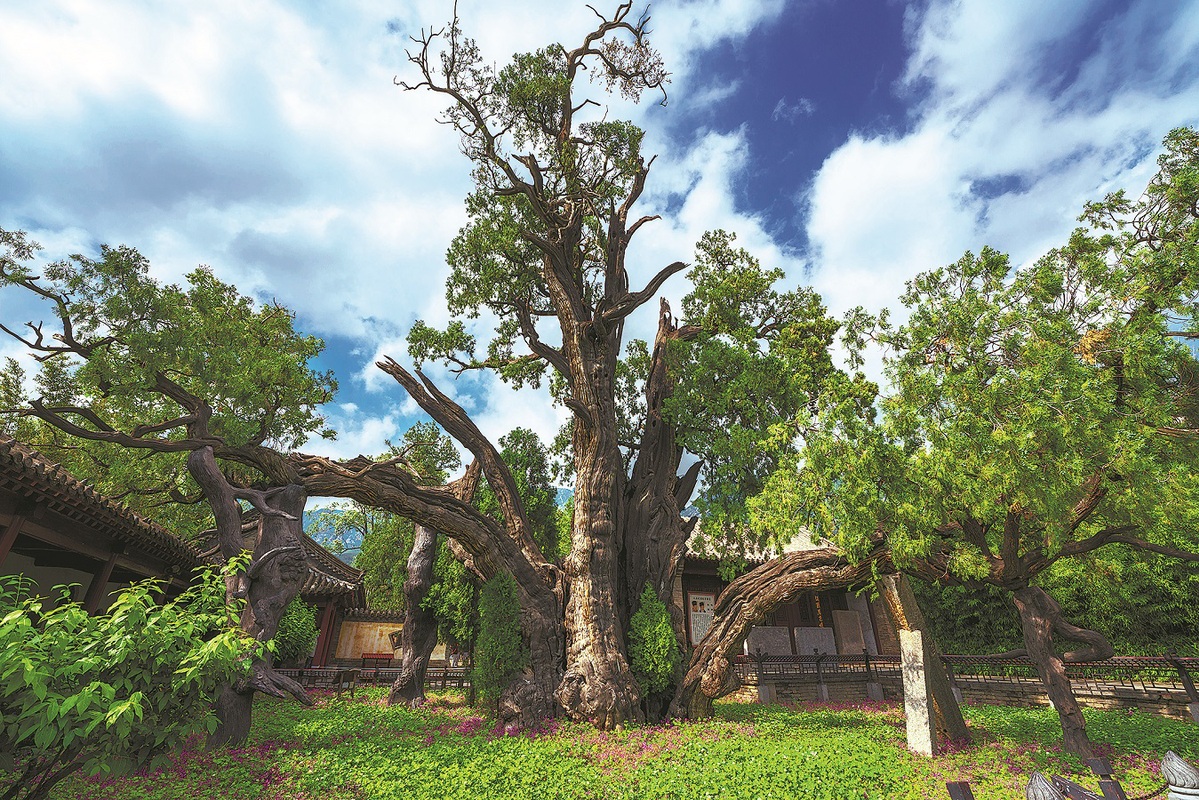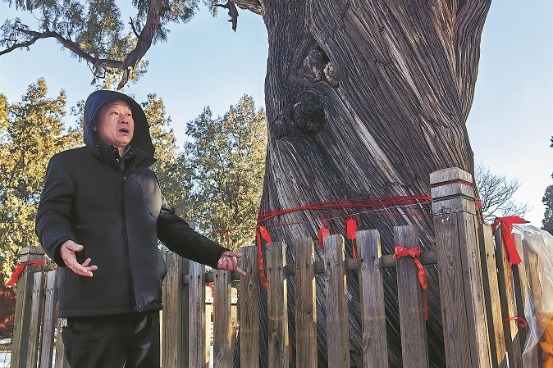Guardians of ancient trees bridge past and future
Preserved natural wonders enhance villagers' wealth, cultural connections


Impressed emperor
The tree's historical significance dates back to 110 BC when Emperor Wu of the Han Dynasty (206 BC — AD 220) visited Songshan Mountain on an imperial inspection tour. Impressed by its majestic stature, he bestowed upon the tree the title of "General Cypress".
Centuries later, in 1750, Emperor Qianlong of the Qing Dynasty (1644-1911) created his renowned ink painting Han Dynasty Cypress at Songyang, which fetched over 87 million yuan ($12 million) at an auction in 2010.
Though local officials began protecting ancient trees as early as 1936 — when the then-magistrate Mao Rucai numbered them and installed enamel plaques — the 2004 campaign marked Dengfeng's first major investment in arboreal heritage.
Bolstered by training from the professor, Jin expanded his arboreal conservation work. By 2008, he led the protection of 878 ancient trees at the Center of Heaven and Earth's eight historic building sites, in preparation for its UNESCO World Heritage application. The center was inscribed on the UNESCO World Heritage List in 2010.
With tight deadlines and some trees in remote mountainous terrain, Jin and his team hauled equipment uphill, camped on-site, and endured nights in tents that had collapsed under heavy rain.
At Songshan Mountain's Zhongyue Temple, where there are over 330 ancient cypresses, Jin faced labor shortages. Despite battling a fever, he recruited 50 laborers and personally trained them, climbing scaffolding repeatedly to demonstrate conservation techniques. He worked through the day, and was given IV drips at night.
Wandering among the ancient cypresses, Jin's voice softened as he recalled the dry clay, which was "hard like stone". "We couldn't use machinery near the roots," he said, describing efforts to dig rejuvenation trenches by hand. "Two workers took a full day to carve out one meter."
During one Spring Festival holiday, he saw three tourists preparing to burn incense next to an ancient cypress to pray for good luck. He changed their minds by telling them "the best worship for ancient trees is to pour a few buckets of water in the dry season".
Jin said in such a harsh environment ancient cypresses grow extremely slowly.
Due to previous methods of determining tree ages being less accurate than today, some trees thought to be about 1,000 years old may actually be over 3,000 or 4,000 years old, he said.
"Ancient architecture valued the natural environment and feng shui, so temples were often built where there were ancient trees. Therefore, the ages of many ancient trees in Zhongyue Temple are likely to be seriously underestimated," he said.
In 2024, Jin's 20-year dedication to conservation earned him a spot on the National Forestry and Grassland Administration's panel of experts. He has now "healed" more than 20,000 ancient trees in provinces across the country, from Shanxi's arid plains to Fujian's humid subtropics.
His phone rings like an emergency hotline, and once his services are requested he rushes to help restore old trees.
Jin believes tree preservation is a multidisciplinary science. Besides anti-erosion treatment and structural reinforcements for hollowed trunks, Jin emphasizes microhabitat management including breathable fences to prevent soil compaction, annual flowers to enrich biodiversity, and strict bans on invasive grasses that starve roots.
"In the north, focus on hydration and aeration. In the south, drainage is key," he said. "But consistent care — judicious watering and loosening soil — is essential."
Jin stresses public awareness about arboreal care to minimize human impact on the growth of ancient trees.
"As long as people avoid harming trunks or roots, reverence for trees — expressed through rituals or worship — is a sacred tradition worthy of respect," he said.























